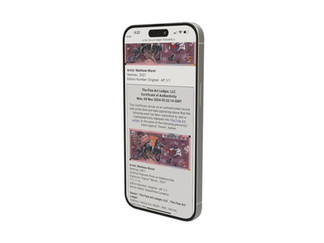Painting Provenance: 5 Reliable Ways to Verify Ownership History
- Aug 2
- 6 min read
The art world thrives on trust, authenticity, and history.
At the heart of all three lies provenance—the complete, documented history of a painting from its creation to the present. Understanding provenance is crucial for collectors, investors, museums, and anyone passionate about fine art, as this history could affects a painting’s authenticity, legal ownership–and value.
Here is a look at what provenance is, why it matters, and five reliable methods to verify the ownership history of a painting, coupled with practical steps and perspectives.
What Is Provenance and Why Does It Matter?
Provenance—from the French provenir, meaning “to come from”—is the chronological record of ownership, custody, and location of a work of art. In simplest terms, it answers the question: Where has this painting been, and who has owned it, since it was created? The record typically includes:
Artist and date of creation
Names of past owners and dates of ownership
Methods of transfer (sale, inheritance, donation)
Exhibitions, publications, and restorations
Physical marks, stamps, or tags on the artwork
An unbroken, well-documented chain of provenance can establish a painting’s authenticity, provide valuable historical context, verify title and enhance its marketability.
Missing or dubious links in provenance may indicate legal or ethical issues (such as theft or illicit export), decrease value, or even render the artwork unsellable through reputable avenues. Provenance is also a critical tool in the ongoing efforts to identify and repatriate art looted during conflicts, most notably during World War II.
For more insight on why provenance is vital and how blockchain is modernizing authenticity, plus practical steps for verifying provenance as a collector, see our complete beginner's guide to art provenance.
The 5 Most Reliable Ways to Verify Provenance
1. Documentation: Certificates, Official Records, and Receipts
Thorough documentation is the foundation of any reliable provenance. Seek out:

Certificates of Authenticity issued and signed by the artist, their estate, or authorized experts
Invoices, receipts, or bills of sale from galleries, auction houses, or previous owners that include detailed information: seller and buyer names, dates, artwork description, and price
Gallery consignment reports and import/export licenses for works traded internationally
This paperwork helps trace the chain of ownership.
If you want more info on how technology is used to document and authenticate art, read Physical Art NFTs Are Here With The Fine Art Ledger!.
2. Exhibition and Publication History
A robust provenance often includes a painting’s public life, evidenced by:

Exhibition catalogues listing the artwork in museums, galleries, or
Publication records in scholarly articles, books, or catalogues raisonnés (comprehensive listings of all works by an artist)
Press reviews or exhibition photographs that feature the painting
Participation in important exhibitions and mention in authoritative publications not only corroborate ownership but greatly enhance a painting’s significance and value.
To learn more about the impact of digital art and public presentation, check NFT's and the Authentication of Fine Art.
3. Auction and Dealer Records
Auction and dealer records serve as public checkpoints in a painting’s journey:
Auction sales records detail hammer price, auction dates, lot numbers, and sometimes buyer/seller identities (though not always public)
Art dealer records include sales invoices, shipping logs, stock books, and correspondence. Renowned auction houses and dealers often keep well-archived records for reference
Specialized databases compile this information, such as the Getty Provenance Index or the International Foundation for Art Research (IFAR) databases. Cross-referencing these can further assert a work’s provenance.
For a perspective on digital diligence and smart contracts in art sales and documentation, see Looking Under the Hood: Diligencing Non-Fungible Tokens, NFT Metadata and Smart Contracts.
4. Physical Analysis: Labels, Marks, and Conservation Reports
The painting itself may hold clues:
Labels or stamps on the frame or canvas from galleries, museums, or large-scale international contemporary art exhibitions, for example a "biennale", held every two years
Inscribed numbers, collector marks, or customs stamps, sometimes hidden on the stretcher or verso (back) of the canvas
Restoration and conservation reports indicating when and where expert work was performed; these are often linked to museum or gallery holdings
Such physical evidence can confirm or challenge the narrative provided by documentation, providing another layer of verification.
5. Database Research and Digital Provenance Tools
Technology now plays a pivotal role in verifying and maintaining provenance:
Catalogues raisonnés and scholarly databases: many major artists have catalogues raisonnés that list individual artworks along with detailed provenance and exhibition histories. Museums and research institutions maintain online provenance resources as well.
Blockchain, NFT and digital registries: Leading platforms like The Fine Art Ledger enable artists and collectors to immutably record artwork details on a tamper-proof digital ledger which requires consensus to change. Here artwork’s history cannot be altered or lost, blending tradition with innovation to secure trust in the digital age.
Using NFTs for this purpose ensures that the artwork’s blockchain record is transferable and can follow the artwork as it changes hands, creating a ‘chain’ of title, or provenance, as the artwork changes hands.
“You can easily record provenance in the Artwork Archive, an online art collection management system... This way you have access to the information when it is time to sell the artworks, whether that be through an auction house, dealer or gallery...”
The Process of Provenance Research: Practical Steps
For buyers, and collectors conducting a professional provenance check generally follows these steps:

Start with the artwork: Examine for labels, inscriptions, and marks. Document every visible clue.
Gather all available paperwork: Request invoices, certificates, and consignment agreements from the seller or previous owners, and verify their authenticity.
Consult published sources: Look for the painting in catalogues raisonnés, exhibition catalogues, art publications like Juxtapoz or ArtReview (to name just two) or scholarly books.
Investigate auction and dealer histories: Search auction databases and reach out to reputable dealers for records.
Leverage institutional expertise: Many museums, auction houses and libraries may be able to assist with provenance research or authentication.
Embrace digital tools: Register new acquisitions on secure platforms like The Fine Art Ledger to future-proof provenance, and store all the above info with the artwork itself, easily accessible with a tap of your mobile phone. .
Challenges and Gaps in Provenance
Even with diligence, gaps in documentation are not uncommon, especially for older works or those affected by war, theft, or undocumented transfers. When gaps appear:
Be transparent; clearly annotate where the record is incomplete.
Seek expert analysis (e.g., technical study, art historian review) to corroborate what can’t be directly documented.
Be wary of “red flag” periods—like Nazi-era Europe—unless exhaustive research has been conducted.
Incomplete provenance can lower value, place title in dispute, or result in legal complications, especially for high-profile sales or loans to major institutions.
Why Secure Provenance Adds Value
Enhances resale potential: reputable auction houses require complete or well-documented provenance for valuable works.
Prevents disputes: Clear ownership history protects both sellers and buyers from future claims.
Contributes to scholarly and collector trust: Well-researched provenance can add a narrative, situating the artwork within an artist’s life, art movements, or historical events.
For further reading, see how digital solutions are changing value in Art Blockchain, Digital Art, the Art World and the Value of Non Fungible Tokens (NFTs).
Provenance in the Digital Age: The Fine Art Ledger Approach
As the art market modernizes, digital solutions are becoming essential. The Fine Art Ledger (FAL) uses technology to store, catalog and make accessible not only the art itself, but all the information relating to the art, making each painting, photographe other work of fine art an accessible and transferable vault of its own information, provenance and authenticity.
This innovation means future collectors, museums, galleries, lenders, art buyers, scholars and patrons can verify and learn about a painting’s journey easily and confidently—no matter how markets or technologies evolve, and without the need for a separately held inventory disconnected from the art. All they will need is the device they use the most: their mobile phones to verify the work of art in front of them.
Take a closer look at FAL’s platform and its impact in Fine Art Provenance, Blockchain & George Michael.
Successfully verifying the provenance of a painting means blending meticulous traditional research—documentation review, physical inspection, commercial and scholarly sources—with the latest digital tools. This not only protects your investment but preserves our shared cultural heritage for generations to come.
If you are eager to secure, investigate, or enhance the provenance of your collection, explore the robust resources and digital tools offered by The Fine Art Ledger—where each painting’s story can be securely written and preserved.






